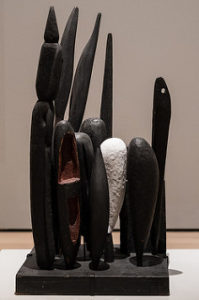STATEMENT
Painting in all possible ways, painting abolition of paint in the object, painting in all its forms. Whether I take pictures, film, sculpt, or install, I explore and exhibit pictorialism.
The disconcerting, disquieting, dumbfounding, or even “de-real-ising” qualities displayed – sometimes simultaneously and sometimes successively – by my work, are because art always differs from the conjectures that arise from any definition of its essence, be it materialist, rhetorical, or artistic. I systematically set out to foil attempts at reifying both art, in general, and my contemporary offerings, in particular. My work is at once polymorphous and protean and, as such, in perpetual expansion, as attested by the multiple techniques and protocols I employed.
WORKS
Iron Maiden
 The words “to cut through”, “to fold”, and “to curve” describe some of the actions that Morgane Tschiember used for the series. The coloured layers seem cut in the space with a cutter. The torsions of curves reveal the metal weight, its force and visual sensuality. With the Iron Maiden Series, there is a tension between the feeling of light fall and the reality of the material used. Built with metal, their scale is made abstract by a colour perfectly applied. The Iron Maiden is between paint and volume; not in between, but in what one constitute the other, its edge, cutting, purely logical, and connective, that enable to pass from two dimensions to three. The artist uses her control of colour, acquired with her practice of painting, and revealed here by the superposition of monochromic shades. This is about the scenography of colour.
The words “to cut through”, “to fold”, and “to curve” describe some of the actions that Morgane Tschiember used for the series. The coloured layers seem cut in the space with a cutter. The torsions of curves reveal the metal weight, its force and visual sensuality. With the Iron Maiden Series, there is a tension between the feeling of light fall and the reality of the material used. Built with metal, their scale is made abstract by a colour perfectly applied. The Iron Maiden is between paint and volume; not in between, but in what one constitute the other, its edge, cutting, purely logical, and connective, that enable to pass from two dimensions to three. The artist uses her control of colour, acquired with her practice of painting, and revealed here by the superposition of monochromic shades. This is about the scenography of colour.
Parallel
Morgane Tschiember creates a real road streaking the space and meeting this universal desire of gravity emancipation. “The object” does not use the metaphor, but at the opposite, it uses physical reality and its integration in space: it is on the dividing line between volume (space), and drawing (plan), painting (light), and picture (time). The black asphalt of this road was like a signature in the space, a graphic sign floating in the air.
Running Bond
The colour is the link, the immateriality uniting two materials; it is the pink, flecked cement inserted and overflowing between the blocks of Running Bond, a series of walls that the artist builds here and there around the world, covering gallery windows and booths in fairs, the better to reveal their artificiality. The Running Bond Series is made of raw breezeblocks, as piled up ready-mades. Cemented by pink mortar, thus brought into relation two substances, one crushed by the other, not mixable and yet violently interconnected. The rough feel contrasted with the visual voluptuousness of the pink. These pieces also establish contact with the spaces in which the supports needed for their stability places them.
Morgane Tschiember plays on the nature of the wall, amplifying its internal links, telling us more about this interstice as an opening, or even as a possible join, than as a spectator. A homage to the mortar that provides solidity through adherence, the Running Bond perfectly symbolise the work of Morgane Tschiember as adhesion to the real, a matching of its most obvious physicality. And it leaves us with our backs to the wall.
Pop Up
 Morgane Tschiember’s “POP UP” are wood volumes covered with lacquer. Their edges reveal different coloured stratums that recall the superposition of glaze leading to a monochrome. They literally come into being. The edge’s thickness is blindingly obvious. Morgane Tschiember explains: “Out of the oven, they celebrate the fact of being, just like the non-birthdays in Alice in Wonderland”. They are not to question. They suddenly appear (violently), they cannot be ignored, expelled, outrageous, coming from nowhere: they were born. Morgane Tschiember says: “Colour coincide with for, the event comes from the rapport between form and colour, a kind of dispersal of one on another, or one in another.
Morgane Tschiember’s “POP UP” are wood volumes covered with lacquer. Their edges reveal different coloured stratums that recall the superposition of glaze leading to a monochrome. They literally come into being. The edge’s thickness is blindingly obvious. Morgane Tschiember explains: “Out of the oven, they celebrate the fact of being, just like the non-birthdays in Alice in Wonderland”. They are not to question. They suddenly appear (violently), they cannot be ignored, expelled, outrageous, coming from nowhere: they were born. Morgane Tschiember says: “Colour coincide with for, the event comes from the rapport between form and colour, a kind of dispersal of one on another, or one in another.
A cosmetic excrescence of the conceptual flatness of the white cube, the Pop Up, considered regarding its most general definition takes over the wall with generative possibilities that seemed to have been forgotten. A seemingly sage matrix, it takes on a magical quality when it blooms with all kinds of exuberantly colourful forms. But beyond this spreading of a space that is usually contained within the walls, kept away from our gaze, compressed and invisible, as if corseted by the stone and plaster, the coating and the cement, there lies another reality, that of a colour from the past or in the future, covered over and to be uncovered.